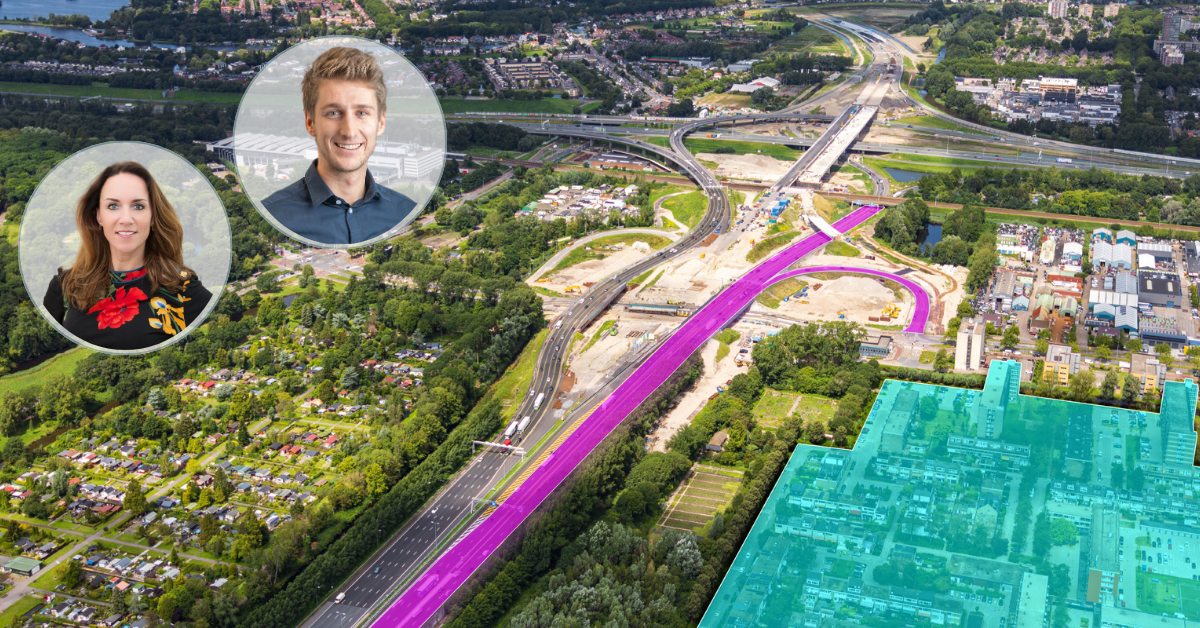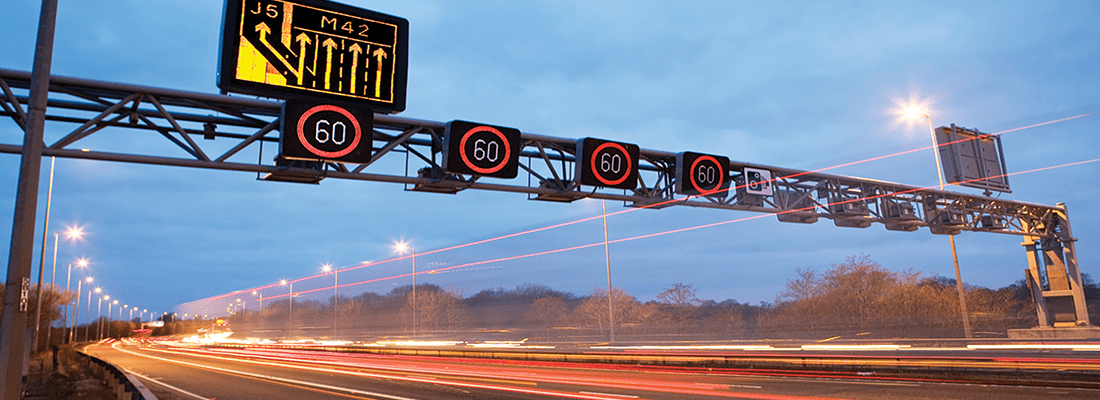All-lane-running smart motorways – controlled by advanced VMS – are one of the flagship success stories of Highways England. Now, as the idea is taken up by other authorities around the world, James Gordon takes a look at the real-time traffic management practices necessary to ensure they work, and asks if a lack of public understanding could be hindering safety and reducing their effectiveness
On the surface, the West Berkshire village of Theale is like any other English hamlet. Small businesses, a school, a railway station and a golf course are its beating heart, while its proximity to the River Kennet puts it in an area of outstanding beauty. Yet, scratch a little deeper and not everything is quite as it seems. The village is also home to large businesses, which lie to the east on its outskirts. Many have located here due to the Berkshire suburb’s easy access to the M4. And now with a 32-mile (52km) stretch of the M4 linking Theale to London – set to become a smart motorway – it’s likely that many more companies will follow.
But this relatively short stretch of asphalt, which when it is finished in 2021/2022, could cost the UK taxpayer as much as £27m (US36m) per mile, has its detractors. Many wonder if smart motorways, which come in three forms – dynamic shoulder running, all-lane-running, and controlled motorways – are safe.
However, Nick Lloyd, the Royal Society for the Prevention of Accidents’ (RoSPA) road safety manager, thinks such fears are unfounded. “Until we see evidence that shows there are safety issues arising from all-lane-running and dynamic-running motorways, RoSPA is not opposed to them. However, that said, we would advocate that further research is carried out as soon as possible, so we can statistically determine whether or not there has been an increase in accidents since they have been rolled out.”
The primary aim of smart motorways is to improve traffic flows and boost capacity without the need to build extra lanes. This is achieved using a mixture of dynamic speed limits and all-lane running. Highways England has already turned 250 miles of its highways into smart motorway, and plans to create a 700-mile stretch of smart motorway from London in the South, to Leeds in the North by 2030, some of which is expected to utilize 5G broadband technology to directly route traffic warnings and diversion information to connected vehicles.
Knowledge is power
But how do road operators win over the doubters, and ensure these super-intelligent stretches of highway work safety and efficiently?
One way of doing so is by educating the driving public. Joshua Harris, the director of campaigns for road safety charity Brake, thinks that opening the shoulder to drivers, a feature of smart motorways, “has raised safety concerns and it is clear that members of the public are not yet comfortable on such roads”.
Harris adds, “It is vitally important that drivers are confident of their road environment and understand the correct procedures to follow – particularly on roads with high speed limits. The roll-out of smart motorways must be accompanied by an increased awareness and communications campaign to ensure drivers know the right road behaviors. A lack of clarity can only lead to dangerous situations and this must be avoided at all costs.”
But with Highways England’s own research pointing to the fact that smart motorways are “actually safer than other motorways” while they improve traffic capacity “by up to a quarter”, is the perceived lack of clarity really an issue?
On message
Jack Cousens, head of roads policy at British motoring association the AA, believes that one of the major issues is not so much around technology, but centers on how vital messaging is communicated by the road operators to motorists. Cousens, who has worked for the AA for eight years in a variety of roles including the AA driving school and manufacturer relations, says, “On smart motorways, the road operator has access to real-time CCTV cameras and radar to monitor the network and identify congestion the second it happens. This technology enables Highways England to gradually reduce the speed of vehicles several junctions away from a tailback, so that when the vehicle reaches the jam – at least in theory – it will have cleared.
“But, what the sign does not tell the driver is where the congestion is and what has caused it. Instead, it simply states, ‘Congestion Ahead, Slow Down’.”
Cousens believes the system would benefit from greater clarity in terms of what messages are telling drivers. “If one says ‘Congestion at Junction 1, Slow Down’, then the driver will instantly know that if he continues to travel at 70mph (113km/h), then he’ll hit the area of congestion, and in doing so, add more time to his journey,” he says.
Steve Gooding, director of the RAC Foundation, a transportation policy and research organization, agrees that more coherent and intelligible messaging is required, and says that, “Information conveyed by VMS, which will display a red X when a lane is about to close, must always be accurate and timely.”
He explains, “The very term smart motorways sets certain expectations. It conjures up ideas of fast-paced, adaptive, reliable traffic management. So if the reality, or even just the perception, is that the technology is not up to the job, because VMS are inconsistent from one sign to the next, or out of kilter with what people are seeing on the road, then the risk is that confidence in the whole system is undermined with potential serious results if the sign they doubt is the red X.
“Data disdain is a real danger. If warning signs and information signs aren’t trusted by some drivers, it puts everyone at risk… Invalid information is, largely, an irritant at the time, but the cumulative effect on motorists’ confidence, and ultimately their compliance, is a serious worry.”
Timely reminders
Despite advances in technology, there are still concerns around the speed and accuracy with which key messaging is communicated via variable messaging signs.
“There are two types of issue,” says Steve Gooding. “One arises where, for example, a sequence of VMS shows different messages because they are set by different systems, or where the reaction time built into the system means that the suspected debris in the carriageway is nowhere to be seen. The other, perhaps most difficult issue is where drivers are required to slow down because of queues or congestion ahead, only to find nothing but free-flowing traffic – precisely because they all slow down – a much trickier communications challenge, but surely not impossible to overcome.”
Education and conflict with other information systems aside, Highways England is confident that its smart motorway network backbone is up to the job. Mark Pellowe, group leader for Highways England Operational Technology Architecture and Infrastructure, says network latency on Highways England’s transmission network, which is one of the largest single networks in the country, does not present an issue to the operational environment.
“Latency is tightly specified and controlled so that the time between any two points on our network, for IP-related services, is no more than 20ms,” he says. “Latency is not an issue, specifically because Highways England appreciates the risks that uncontrolled latency may present and therefore we must ensure that it is consistent.
“For message signs that display information to the traveling public, a 20ms latency between the central system requesting the message, and the sign receiving and displaying it, is tiny in comparison to the time it may have taken for the control center to become aware, and the information about the incident is simply that – information – and not an instruction [e.g. a speed limit change] to the traveling public.”
Chasing away phantoms
If latency is not a concern, why do some motorists complain about VMS information that is no longer relevant, or signage warning drivers of congestion that isn’t actually there? The answer is often that it is precisely because a smart motorway is working well that congestion appears to vanish. One of the primary aims of smart motorways is to reduce the instance of phantom jams, which occur when traffic is too dense and fast, and the sharp braking of one vehicle causes other vehicles behind to slow. In dense traffic, this can create a domino effect that eventually results in all the traffic coming to a standstill. If variable speed limits successfully slow traffic, then this domino effect can be avoided, or reduced, so that serious congestion never occurs.
Pellowe explains, “The MIDAS [Motorway Incident Detection and Automated Signalling] algorithms use input from buried magnetic induction loops or radar to determine traffic flow levels, and in some situations will request the central system to set advisory speed limits automatically [in line with safety-focused system rules], or inform road users of the potential queue ahead.
“These algorithms have been developed over the years by the traffic engineering industry in cooperation with Highways England, and seek to encourage traffic to slow down to, for example, stop a queue forming, or protect the back of a queue – among other traffic flow and information purposes.”
So, in fact, the main problem is with education. Motorists complaining about non-existent congestion need a deeper knowledge of the workings of smart motorways.
Meanwhile, for their part, traffic engineers are constantly monitoring the control systems to attempt to ensure they work as effectively as possible. “The algorithms are under constant review,” says Pellowe. “Specific, site-based values can be individually configured, as can wider global variables such as the minimum setting time being reviewed. Updates can then be made to the traffic engineering algorithms. There are specific teams working continuously in this arena to monitor and improve on-road performance.”
The only problem is, the more effective these systems become, the more pressing will be the need for public education.
Smart workzone VMS
Using Google probe data, a UK-based VMS provider is
able to display up-to-the-second diversion route travel times at the roadside
Another challenge that road operators must meet is accurately communicating the impact of freeway workzones on journey times. Too often, data that is relayed to the drivers is inaccurate or incorrect. So how do road operators solve this? Many think the answer lies in big data, and Highways England and its technology partners are already leveraging data to deliver shorter roadwork cycles.
To better manage traffic during recent construction work on the M60/M62 Smart Motorway Upgrade scheme in Manchester, for instance, Highways England reached out to Rennicks UK, a road signage technology provider, for help.
Managing director Ross Bullerwell takes up the story: “We use Google data to provide journey-time information for motorists on our portable VMS. It tells them exactly how long it will take to get through strategic diversion routes. We believe that our system is fairly unique because it takes into account the many nuanced and varying peaks and troughs of rush-hour traffic: information that the current one-dimensional systems employed today cannot process or communicate.”
And so what is the science behind the technology? Bullerwell explains, “We begin by collecting live travel information from the Google Application Programming Interface. This anonymized crowdsourced information is drawn from cell phones, floating data from connected vehicles and roadside infrastructure. It is then further refined by algorithms processing millions of units of data, which then generate and update the journey time every 20ms.”
Bullerwell, who has worked in highways for the past 20 years in both the private and public sectors, thinks that real-time journey technology will be used much more extensively in years to come.
“Not only does it provide the driver with the most up-to-date information available, but it has the potential to save road authorities millions of pounds each year because one of the chief benefits of the technology is that it breaks the constant, iterative cycle of deploying and decommissioning standard time technology, which requires skilled engineers to attend the site every day.”
So does Bullerwell think that a national roll-out of the technology could revolutionize how construction site information data is gathered and communicated to drivers?
“No system is infallible, and the success of our technology is reliant on other platforms for accurate data,” he says. “But, yes, I believe it will significantly improve communication between road operator and driver.”
The death of VMS?
Connected and autonomous vehicles make it possible to imagine a time when road signs are no longer needed. But how close is such a revolution?
With road operators moving more toward smart motorways and a connected vehicle revolution underway, could VMS boards, and the gantries they sit on, be consigned to history?
Jack Cousens at the AA believes that signage will be a necessary part of the road landscape as long as drivers have the capacity to control their vehicles, arguing that when we reach Level 5 autonomy, signage will no longer be required.
He says, “If and when fully autonomous driving technology emerges where there is no way that the vehicle can hand responsibility back to the driver, logically speaking, there would be no reason to know why the vehicle is doing what it is doing, other than the fact that it is taking you to your destination.”
But Steve Gooding from the RAC, thinks that “this Holy Grail of traffic management”, where cars will talk to each other and the surrounding infrastructure to communicate road conditions and traffic information, and make a better decision than a human being, “is some way off”.
“It is sobering to remember that there are still thousands of miles of roads in Britain where a driver who breaks down can’t even get a cell phone signal to call for help, let alone use the existing apps that might make travel easier,” he says. “But even with the connected revolution coming, there is likely to be a place for traditional systems as part of an overall information networks – go to any railway station and you’ll see people with all the latest travel information on their phones diligently studying the train departure board.”




